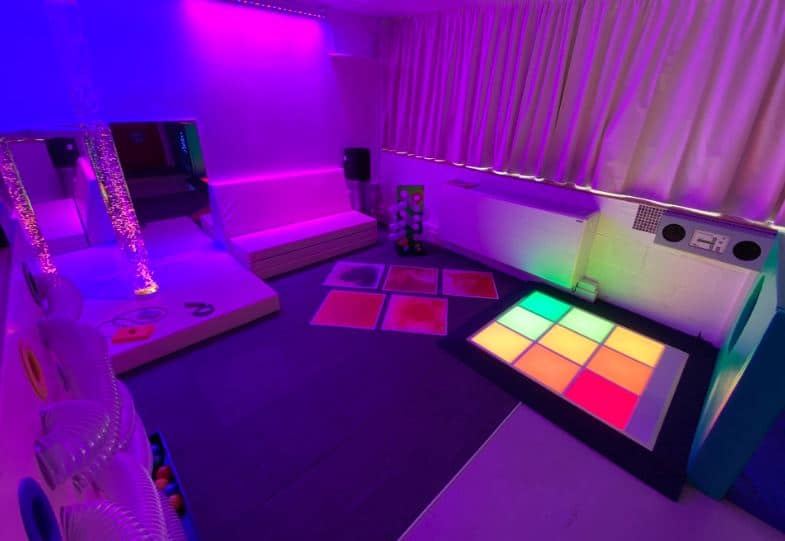
For Educators & Parents, Sensory Spaces are Invaluable and Supportive for Kids
Creating a sensory space in a home or a school is growing trend, and has many benefits for both students and educators. Dedicating a space or a room to the sensory needs of students can help educators create the most beneficial learning environment for all of their students. It is not uncommon for educators to have a student that may need an adjustment in their attitude or surroundings, so the ability to offer them a time out in a sensory space can help them take time to calm down, while allowing teachers to make a non-punitive removal from the classroom.
[Time outs] are recommended by most pediatricians as a way to curb negative behaviors ranging from talking back to physical aggression. Research indicates that when used properly — along with other techniques that balance nurture and structure — time outs are effective and do not cause harm.
Child Mind Institute “Are Timeouts Harmful for Children“
One of the arguments (dismissed by most child psychologists) against timeouts is that it isolates children. As noted above, when used properly, they’re effective. However, time outs in sensory spaces contribute to positive behavours and outcomes. It enhances the child/student’s experience and aides in calming behaviour and aggression.
Sensory space in a school can have a calming effect
Although the goal of a classroom is to foster inclusion and acceptance, there are times when a child may need to be removed due to attitude or behaviour issues. However, punishing this behaviour can often lead to a child acting out further, whether out of anger or confusion. Having an on-site sensory space can present the teacher with an opportunity to give the student space to calm down on their own, without the pressure of their classmates nearby. Often removing a child from a situation and placing them in a calming space will have a more positive result than punishing them would.
A sensory space that is filled with calming features can help these students naturally release their anger and anxiety, leading to a calmer interaction when they return. Features like dim lights, comfortable chairs, quiet music, and low stimulation toys can help a child improve their reactions and behavior naturally.
Beneficial for everyone involved
When a child is being disruptive in class, they can be a distraction to everyone in the room. In these situations, the most beneficial option for everyone is to remove the disruptive child from the space so that the remaining students can continue on with their day. However, simply sending the child into the hallway or down to the office isn’t likely to heal the issue that led to their disruptions in the first place. A sensory space can offer children a dedicated and quiet place to take a time out and reflect on the situation, without pushing for an immediate resolution. This option is beneficial for everyone involved for many reasons.
- Helps relieve the teacher during a stressful situation
- Offers the removed student the opportunity to calm down and distance from the situation in their own unique way
- Provides a place to retreat to when the school setting becomes triggering or stressful
- Gives teachers a safe space to interact with and learn about their unique students
- Allows providers to understand and learn about the needs of individual students, and cultivate a space that helps them feel safe
- Allows the rest of the class to be separated from disruptive behaviour
- Sometimes participants need space from each other, which a sensory room can provide
- Kids with sensory processing and learning disorders like ADHD and Autism
A sensory space doesn’t have to be fancy or complicated
When you start looking into the features to include in a sensory space there are nearly endless options of activities, toys and tools. However, a sensory space doesn’t have to be expensive or fancy. Simply providing a space for students to retreat to when they need it can make the difference for many kids. Including a projector or virtual reality tech can be a fun and helpful addition, but often starting simple with good lighting, a variety of books, interactive toys, and calming sounds with comfortable places to sit is a great way to go.
A sensory space is not a punishment
Regardless of why a child is encouraged or led to visit a sensory space, it is essential that they do not come to see it as a punishment. Many children process things in unique ways, so a sensory space is a great way to honour their uniqueness while also removing them from a triggering situation. This removal helps the remaining children feel safe and cared for, while also offering the disruptive student a break without being punished.
Many options for creating a great sensory space
Whether you’re able to dedicate an entire room or are just looking to furnish a small space or mobile cart, there are no rules for how to create a sensory space. Teachers can band together to plan and fill the space with tools they think would help, or they can contact a professional to help them create the perfect space. Sensory room concierge services are designed to evaluate the needs of everyone involved and advise or curate the tools that will have the biggest impact. Teachers spend so much of their time looking out for the best of their students, and creating a great sensory space is another tool that will help them continue to do that.



